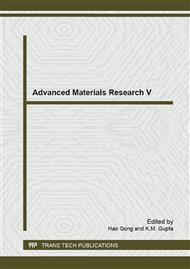p.178
p.182
p.190
p.195
p.203
p.208
p.215
p.220
p.225
Preparation and Characterization of Hydrogels Based on Chitsoan/Polyvinyl Alcohol Blends
Abstract:
In this study, a series of poly (vinyl alcohol) (PVA)/chitosan (CS) hydrogels with different weight ratio of PVA to CS were prepared by freezing-thawing (F-T) method. The structure, morphology, and crystallinity of hydrogels were investigated by Fourier Transform Infrared (FT-IR), scanning electron microscopy (SEM) and differential scanning calorimetry (DSC). FTIR demonstrated the presence of strong intermolecular hydrogen bonds between CS and PVA molecules. SEM images showed that the higher the chitosan, the greater the porous size of the hydrogel and DSC confirmed that crystallinity is higher when PVA is more in hydrogel. The mechanical properties of these hydrogels were studied by rheometry. The study of swelling ability demonstrated that the hydrogel developed with PVA and Cs was more swellable than that with PVA only because of its cross-linking interaction with PVA.
Info:
Periodical:
Pages:
203-207
Citation:
Online since:
May 2015
Authors:
Keywords:
Price:
Сopyright:
© 2015 Trans Tech Publications Ltd. All Rights Reserved
Share:
Citation:


